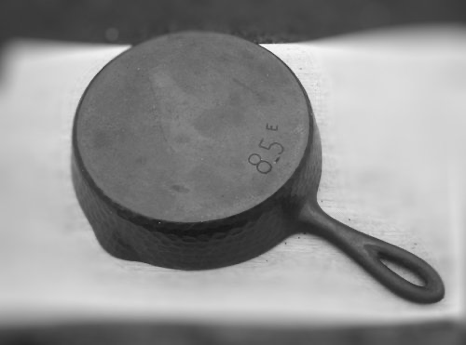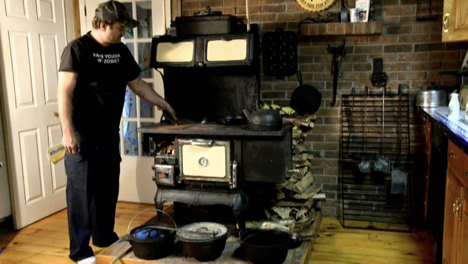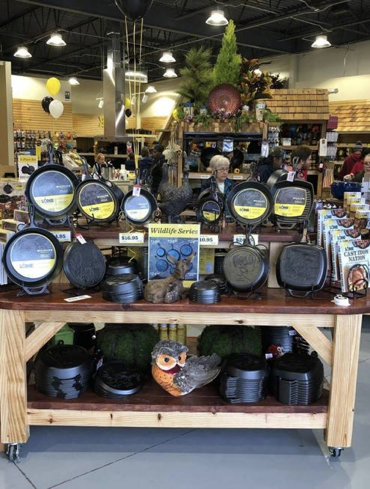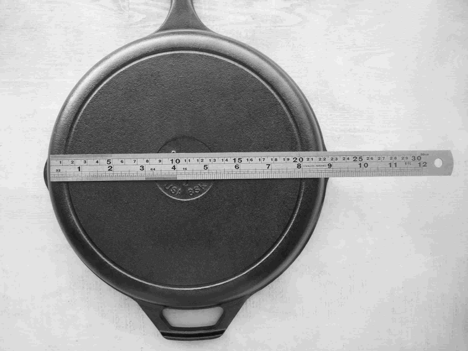Cast Iron Pan Numbers and What they REALLY Mean
My son, who plans to eventually live off-grid, has been collecting cast iron skillets. From Dutch oven cookers, and frying pans from large to small, every piece has a number (and often a letter) either on the handle or on the under-side.

We wondered what this information meant. Turns out, the numbers are size numbers. But sizes of what? Here’s what we learned on a very helpful site, www.castironcollector.com:
Often, the assumption is erroneously made that the large numeral, found normally either on the top of the handle or on the bottom of a piece, indicates its diameter in inches. A measurement of both the top and the bottom rim of a pan, however, will quickly confirm that the number has no direct correlation to either dimension.
With the advent of wood-burning stoves, pans were produced to conform to the sizes of the openings in their tops known as "stove eyes". Think of a stove eye as a burner on a modern stove. (Some people still call them that.) A heavy cover piece was left in place when an eye was not directly in use, and removed (using a special, heat-resistant lifter handle), when maximum heat from the eye was required.

Early cast iron pans were made with heat rings. Heat rings, the rims protruding from the bottom circumference of most early cast iron pans, served multiple functions: as a "seal" of sorts between the pan and stove eye, as added stablility for less-than-perfectly flat pan bottoms, and as a device to help reduce hot spots.

Depending on the brand of stove, and the sizes of its various eyes, appropriately-sized pans were needed to work efficiently with the stove. Or, in some cases, the stove maker also produced pans, customized to work with their units.
Even after gas-fired ranges (and, eventually, electric stoves) became universal, cast iron cookware continued to be manufactured in the sizes and with the designations originally established for its use on wood-burning stoves.

For instance, a 1924 Wagner Manufacturing Co. catalog gives these as the bottom diameters of their regular cast iron skillets:
#2 - 4-7/8"
#3 - 5-1/2"
#4 - 5-7/8"
#5 - 6-3/4"
#6 - 7-1/2" #7 - 8-1/4"
#8 - 8-7/8"
#9 - 9-3/4"
#10 - 10-1/4"
#11 - 10-7/8" #12 - 11-3/4"
#13 - 12"
#14 - 13"
Things can become more confusing with the addition of letters: "3B" or "8CX", or "710D" or "1053C". The letter or letters after the numerals are what's known as pattern letters. Each model of pan a foundry produced had to have at least one pattern from which to make its molds.

As an effort to mass produce popular-size pans, multiple patterns would be created. Over time, patterns would wear or suffer damage, the result of which would end up being cast into the pan. It was important, therefore, to know which pattern currently in use was creating sub-standard pieces. A unique letter on each working pattern provided the solution.
Hmmm, not sure I got that, how about you? And let me tell you, the cast iron collector goes on for many more paragraphs discussing all the markings you might find on a piece. It’s actually rather complicated.

SO unless you intend to become an avid collector, maybe the bottom line will suffice? Instead of trusting any numbers or worrying about letters you see on a cast iron pan, trust a ruler instead. When shopping for cast iron, bring a ruler or tape measure along and take the time to measure across the top to ensure you’re getting the size pan you actually want. (Whew! Who knew?)

We wondered what this information meant. Turns out, the numbers are size numbers. But sizes of what? Here’s what we learned on a very helpful site, www.castironcollector.com:
Often, the assumption is erroneously made that the large numeral, found normally either on the top of the handle or on the bottom of a piece, indicates its diameter in inches. A measurement of both the top and the bottom rim of a pan, however, will quickly confirm that the number has no direct correlation to either dimension.
With the advent of wood-burning stoves, pans were produced to conform to the sizes of the openings in their tops known as "stove eyes". Think of a stove eye as a burner on a modern stove. (Some people still call them that.) A heavy cover piece was left in place when an eye was not directly in use, and removed (using a special, heat-resistant lifter handle), when maximum heat from the eye was required.

Early cast iron pans were made with heat rings. Heat rings, the rims protruding from the bottom circumference of most early cast iron pans, served multiple functions: as a "seal" of sorts between the pan and stove eye, as added stablility for less-than-perfectly flat pan bottoms, and as a device to help reduce hot spots.

Depending on the brand of stove, and the sizes of its various eyes, appropriately-sized pans were needed to work efficiently with the stove. Or, in some cases, the stove maker also produced pans, customized to work with their units.
Even after gas-fired ranges (and, eventually, electric stoves) became universal, cast iron cookware continued to be manufactured in the sizes and with the designations originally established for its use on wood-burning stoves.

For instance, a 1924 Wagner Manufacturing Co. catalog gives these as the bottom diameters of their regular cast iron skillets:
#2 - 4-7/8"
#3 - 5-1/2"
#4 - 5-7/8"
#5 - 6-3/4"
#6 - 7-1/2" #7 - 8-1/4"
#8 - 8-7/8"
#9 - 9-3/4"
#10 - 10-1/4"
#11 - 10-7/8" #12 - 11-3/4"
#13 - 12"
#14 - 13"
Things can become more confusing with the addition of letters: "3B" or "8CX", or "710D" or "1053C". The letter or letters after the numerals are what's known as pattern letters. Each model of pan a foundry produced had to have at least one pattern from which to make its molds.

As an effort to mass produce popular-size pans, multiple patterns would be created. Over time, patterns would wear or suffer damage, the result of which would end up being cast into the pan. It was important, therefore, to know which pattern currently in use was creating sub-standard pieces. A unique letter on each working pattern provided the solution.
Hmmm, not sure I got that, how about you? And let me tell you, the cast iron collector goes on for many more paragraphs discussing all the markings you might find on a piece. It’s actually rather complicated.

SO unless you intend to become an avid collector, maybe the bottom line will suffice? Instead of trusting any numbers or worrying about letters you see on a cast iron pan, trust a ruler instead. When shopping for cast iron, bring a ruler or tape measure along and take the time to measure across the top to ensure you’re getting the size pan you actually want. (Whew! Who knew?)
Sources:
- www.castironcollector.com
- www.youtube.com
- www.booniehicks.com
- www.lodgemfg.com
- www.etsy.com
- www.thespruceeats.com
 Alice Osborne
Alice Osborne
Weekly Newsletter Contributor since 2006
Email the author! alice@dvo.com
